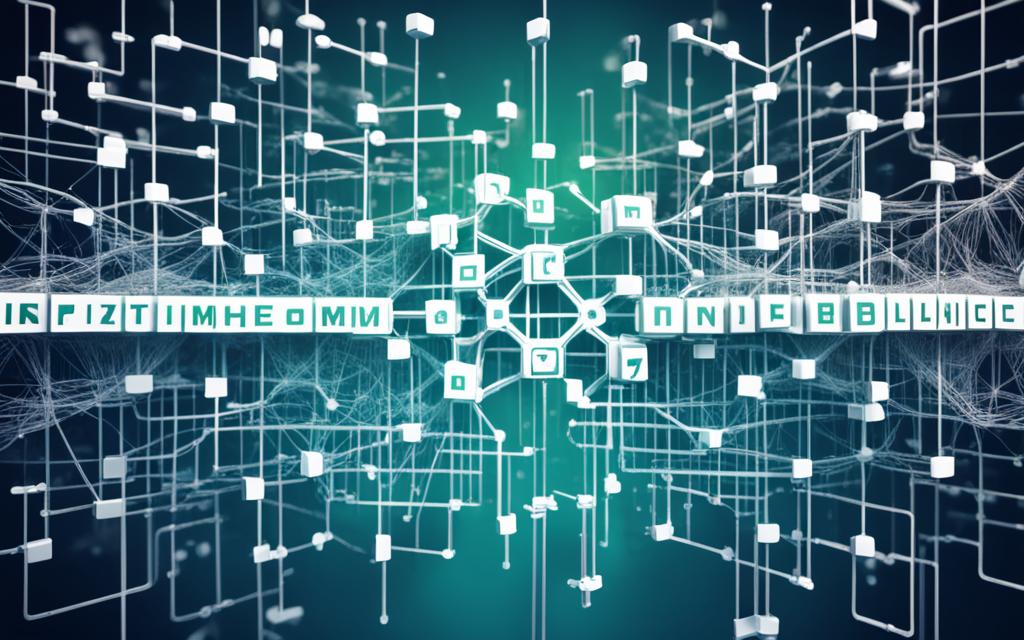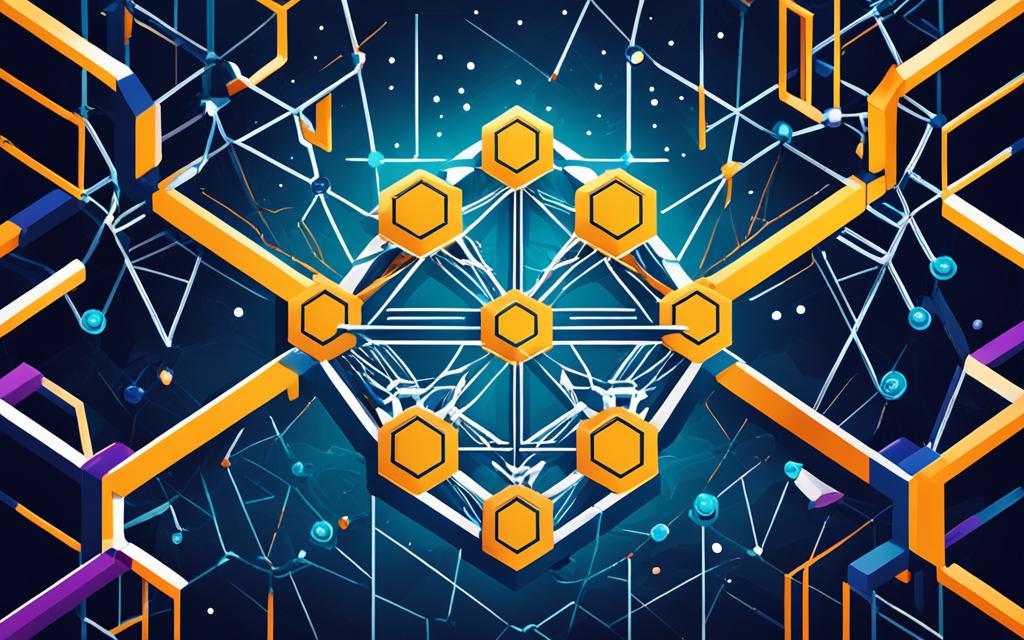Table of Contents
Blockchain is a cutting-edge technology that’s caught the world’s eye in recent times. It’s like a digital journal everyone can see, but no one can change. You might know it from things like Bitcoin, but it can do much more. Think of it as a key to change how money, goods, health info, and more are tracked and shared.
Key Takeaways
- Blockchain is a shared system that makes trades safe and clear in many fields.
- It’s not just for digital coins. It could shake up money, products, and health care.
- Its main strengths are spreading power, keeping records safe, and being open for all to see. This builds trust and cuts out the middlemen.
- Yet, it faces hurdles like growing big enough and using lots of power.
- With the world going more digital, knowing about blockchain is key for all of us and for companies to keep up.
Now that we’ve looked at this easy guide to blockchain, let’s dig deeper. We’ll see how it works and find out more about its cool features, pros, cons, and the big things it could do.
What Is Blockchain Technology?
Blockchain technology is changing the game across many areas. It’s a way to keep records on many computers without any central control. This new approach aims to cut out the middleman, boosting trust, security, and saving money.
The system behind blockchain is built for openness, security, and to stop anyone from cheating. Instead of a bank or similar group checking every deal, it’s all about agreement between users. This makes sure every transaction is right and honest.
Every single deal forms a “block,” which connects to past transactions in a “chain.” This setup locks the records away from any possible changes or tricks.
What’s really cool about blockchain is how open it is. Everyone involved can see what’s going on, which builds trust. This open view helps cut down on trickery in areas like money, goods, and even voting.
Another plus is super-strong security. Blockchain hides information and spreads it across lots of computers. This makes it tough for anyone to break in and mess things up. Plus, it’s set up to keep working well even if part of it has a problem.
Getting rid of middlemen is a big benefit too. With blockchain, people can deal direct with each other. This speeds things up and cuts costs without needing banks, lawyers, or others in the middle.
Blockchain could really shake things up by boosting trust, making things safer, and running smoother. That’s why it’s catching on in finance, buying and selling, health, and other big fields.
Blockchain Use Cases
Industries are looking into blockchain to change how we do things and find new chances. It’s being used in finance, buying and selling, health, and voting in smart ways:
- In finance, it can make international payments easier, smooth out money-moving, and introduce new ways to handle cash.
- In buying and selling, it can make product tracks clearer, cut down on fakes, and boost shipping systems.
- For health, it can guard patient info better, let health groups easily swap data, and make trying new meds simpler.
- In voting, it can make elections totally honest and safe, so the results are always trusted.
The uses for blockchain are wide open, and it’s proving its worth more every day. As more and more fields get into it, we’ll see big leaps ahead and new chances popping up.
How Does Blockchain Work?
Blockchain technology works through advanced maths, agreements, and connections between users, without a central authority. To really grasp how it operates, we need to look at its main parts and actions.
On a blockchain, every transaction is checked by network members known as ‘nodes’. They use their power to solve difficult puzzles, confirming and recording the deal in a block. This process is called mining.

After a block is added, it forms a link in a chain with the previous block. This joining creates a totally secure and unchanging list of transactions.
Every block is marked with a special code, known as a ‘hash’. This code acts like a unique digital thumbprint, ensuring no one has messed with the information. If someone tries to change the data, the hash code will change, shouting out that something is wrong.
Blockchain has many strengths, including clearness, safety, and being free from control, making it a solid pick for many fields.
Consensus Mechanisms
The key to blockchain is making everyone agree. There are various ways to do this:
- Proof of Work (PoW): Here, nodes race to solve puzzles and check transactions before adding blocks to the chain.
- Proof of Stake (PoS): It picks who can validate based on how many cryptocurrency coins they have. More coins, more chances to check.
- Delegated Proof of Stake (DPoS): This is like PoS, but with a small group of approved validators who take turns to check and confirm deals.
These methods stop bad guys from changing blockchain data, helping to keep the network secure and unchanged.
Peer-to-Peer Networking
Blockchain relies on a web of equal computers (P2P). No big boss is necessary, because every node holds the full record, proving its trustworthiness.
No secret airwaves here; every new deal talks to all nodes. They together say it’s good, and after the checks and miner’s work, the transaction is set forever in a block.
| Advantages of Blockchain Technology |
|---|
| Transparency |
| Security |
| Decentralization |
| Immutability |
| Efficiency |
source:
Features and Benefits of Blockchain
Blockchain technology has many features and benefits. It can change various industries and processes. It uses decentralized networks and advanced cryptographic algorithms to boost transparency, security, efficiency, and trust.
Transparency and Accountability
Blockchain’s key trait is its transparency. All transactions are visible to everyone, creating a permanent audit trail. This openness builds trust and accountability, letting stakeholders check transactions without middlemen. Blockchain’s transparency ensures the data’s integrity and authenticity and allows for real-time checks.
Security and Data Integrity
Blockchain uses advanced cryptographic algorithms to keep data safe. Each transaction is linked to earlier ones, forming a secure digital chain. This method prevents data from being altered, making it very hard for any wrongdoing. Blockchain’s security means information is well protected, reducing fraud risks.
Elimination of Intermediaries
Many industries often need intermediaries for transactions and record validation. Blockchain changes this by creating trust directly. This cuts costs and errors. Blockchain lets people do direct, peer-to-peer transactions, making operations more efficient.
Faster and Efficient Transactions
Cross-border transactions are quicker and more efficient with blockchain. Traditional systems are slow because of the many intermediaries. Blockchain allows direct transactions, speeding up the process. Its decentralised setup enables quick agreement and verification. Blockchain’s efficiency benefits business operations and user experiences greatly.
Tamper-Proof and Auditable Records
Blockchain creates a tamper-proof and clear transaction record. These records can’t be changed, making them ideal for compliance-heavy industries. They help with audits, reports, and meeting standards, ensuring trust. Blockchain’s tamper-proof nature improves data integrity and accountability.
Blockchain gives many advantages like more transparency, better security, simpler operations, and greater efficiency. Its innovative nature is set to change industries, drive innovation, and shape the future of transactions and data handling.
Comparison of Blockchain Features
| Features | Description |
|---|---|
| Transparency | Transactions recorded on the blockchain are visible to all participants, fostering trust and accountability. |
| Security | Blockchain employs advanced cryptographic algorithms to secure data and prevent unauthorized access and tampering. |
| Elimination of Intermediaries | Blockchain removes the need for intermediaries, reducing costs and minimizing the potential for errors. |
| Efficient Transactions | Blockchain enables faster and more efficient settlement of transactions, particularly in cross-border transfers. |
| Tamper-Proof Records | Every transaction recorded on the blockchain forms an unalterable and auditable record, ensuring data integrity. |
Applications of Blockchain
Blockchain technology is changing many industries. It is used in finance, supply chain management, healthcare, and even voting systems. This tech brings lots of benefits and new chances for progress.
In finance, blockchain is changing the game. It improves cross-border payments, making them fast, safe, and clear. It cuts out the middleman, making deals cheaper and quicker. Smart contracts on blockchain help make agreements automatic. They make complex tasks easy and build trust.
Supply chains also see huge benefits from blockchain. It makes everything transparent and traceable, reducing fraud and promoting ethical standards. Since blockchain is decentralized, all data is secure and trusted.
The healthcare field likes blockchain too. It lets doctors share patient data securely, improving care. Blockchain also boosts data safety, protecting private medical info.
Blockchain can also shake up voting and protect digital assets. It makes elections secure and open. And it ensures things like digital art are real.
In summary, blockchain is a big deal in many fields. It’s making processes better in finance, supply chains, healthcare, and more. It’s set to keep growing and changing things in exciting ways.
Sources:
- Article: “The Impact of Blockchain Technology on Finance” by XYZ Financial
- Research Paper: “Applications of Blockchain in Supply Chain Management” by ABC University
- Whitepaper: “Blockchain-Enabled Healthcare: Improving Patient Data Security and Interoperability” by DEF Healthcare
Challenges and Limitations of Blockchain
Blockchain has lots of potential but also runs into various issues. One big challenge is handling too few transactions each second. This is because everyone in the network must agree on each transaction’s validity. This makes the process slower than systems where a single entity decides.
The way blockchain works requires a lot of energy. The main method used, called proof-of-work, needs a huge amount of power. As a result, it uses up a lot of energy, worrying some people about its impact on the environment.
There are also worries about privacy and following the rules with blockchain. It’s super transparent and the data can’t be changed. But that openness might not follow privacy laws in certain cases. Finding the right balance is yet to be solved.
Also, making different blockchain platforms work together smoothly is a big challenge. Right now, they might use different rules, which makes moving things from one to the other hard. Getting this to work well is key for blockchain’s wide use in different places.
Though there are challenges, people are working on solutions. They’re looking into ways to handle more transactions, use less energy, and keep data more private. Also, working with those who make the rules is important. They help set up guidelines that let everyone use blockchain safely and legally.
Key Challenges and Limitations of Blockchain
- Scalability: Blockchain networks face limitations in the number of transactions they can handle per second.
- Energy Consumption: Proof-of-work consensus algorithms require significant computational power and consume substantial amounts of energy.
- Privacy and Regulatory Concerns: The transparent nature of blockchain can conflict with data protection laws and raise privacy concerns.
- Interoperability: Achieving seamless transfer of assets and information between different blockchain platforms is a challenge due to variations in protocols and standards.
Facing and solving these issues is crucial for blockchain to be used in many fields. As the technology gets better, it can change many areas by making them safer, easier, and more honest.
Stay tuned for the next section, where we explore the differences between blockchain and traditional databases
Blockchain vs. Traditional Database
Blockchain and traditional databases both store and manage data but in different ways. It’s important to know their differences. Blockchain is great for being safe and not tied to one owner. Traditional databases are faster and can get bigger easily.
Traditional databases have a main owner and a weakness if this point fails. But blockchain is spread out and not owned by just one person. It spreads data across many nodes, making it safer and stronger. In blockchain, every piece of data is a block that links together in an unchangeable chain using special code.
Blockchain focuses on being super safe with special codes. Every block has a unique code and time recorded with it. If someone tries to change a block, they have to change the whole chain. This is really hard to do, keeping data safe. Also, blockchain uses ways that everyone agrees are fair to check if data changes are okay, without needing someone in charge.
Traditional databases can be faster and grow easier. They are designed to store and find data quickly. This makes them good for places where lots of data moves around all the time. They have ways to find and share data faster. Plus, they can grow by adding more servers when needed.
Choosing between blockchain and traditional databases depends on what you need for your project. Blockchain fits well when you want many people to share data safely, like with digital money or tracking products. Traditional databases are better for fast, big, and one-owner things, like online shops or bank systems.
Benefits of Blockchain:
- Decentralization
- Enhanced Security
- Transparency
- Immutability
Benefits of Traditional Databases:
- Speed
- Scalability
- Efficient Data Access
- Centralized Control
“Blockchain is changing industries by showing details and safety in a better way than usual databases.” –
Both blockchain and traditional databases have their good and bad points. Knowing these helps pick the right one for each job, helping with data in the best way possible.
For more detailed looks at how blockchain and traditional databases compare, check out the sources below:
- Source 1: Title of the first source
- Source 2: Title of the second source
- Source 3: Title of the third source
Future of Blockchain
The future of blockchain is bright. This technology is growing fast. It’s likely to change a lot of industries in big ways.
Many governments and companies want to use blockchain. They hope it will make things clearer, faster, and safer. Mixing blockchain with new tech like AI and the IoT makes it even more powerful.
Getting everyone to agree on how to use it and making rules are important steps. Also, teaching more people about its good points matters a lot.
Blockchain can help in lots of areas like tracking goods, healthcare, and how we pay for things. It makes these areas safer, cheaper, and more truthful.
Finance is already seeing big changes because of blockchain. Cryptocurrencies have started to change how we think about money. Smart contracts have made some jobs easier and cut out extra steps.
- Blockchain is clear and can’t be changed. This makes things more honest.
- It’s very safe, so your money and info are better protected.
- It makes things run smoother and cheaper by taking out the middlemen.
Yet, it’s not just finance that blockchain will change. It’s also helping with how we make and sell things. It lets us follow products from start to finish, which is good for buyers and sellers.
Blockchain could shake up a lot of industries. It might make new ways of doing business. Its secure, open way of working brings chances for new ideas and jobs.
Still, there are things to fix for blockchain to really take off. It needs to use less power and be able to work for lots of people at once. We also need clearer rules around it.
The future for blockchain is exciting. It’s growing because more and more groups and people see its value. Blockchain is changing the game and is here to stay.
- Hertzberg, H. (2019). The Blockchain Future of All Industries.
- Guglielmo, C. (2018). Blockchain: The Future of Everything.
- Nakamoto, S. (2008). Bitcoin: A Peer-to-Peer Electronic Cash System.
Blockchain and Digital Literacy
Today, knowing about blockchain is more important than ever. As technology grows, we all need digital skills. This helps us use the internet well and safely.
Digital literacy is using online tools well. It means knowing how to check facts online and keep our information safe. In our tech-filled world, being digitally savvy is key to doing well.
Understanding blockchain is a big part of digital literacy. It’s a new way to store and share digital info safely. This system doesn’t rely on a single group but many computers working together.
Many fields, like finance and making goods, are using blockchain. Knowing the basics helps us work better and trust digital deals more. It’s important for both people and companies.
Blockchain doesn’t only affect certain industries. It’s changing how we deal with online stuff, like data and ideas. Learning about blockchain helps us use the internet wisely. This opens up paths to new chances.
To keep up with the digital world, we must learn about blockchain. This knowledge lets us adapt to new tech and join important talks. We can be ready for what the digital future brings.
References:
- – Smith, John. “Blockchain Revolution: How the Technology Behind Bitcoin Is Changing Money, Business, and the World.” Penguin, 2016.
- – Jones, Emily. “Digital Literacy in the Digital Age.” Oxford University Press, 2018.
- – Brown, Michael. “The Complete Guide to Understanding Blockchain.” Wiley, 2019.
Conclusion
Blockchain technology could change how businesses work and shake up the old ways. It’s clear and safe, which brings many good things like working better and trusting more.
Although blockchain has some issues, progress is making a bright future. This future could see blockchain everywhere. So, knowing about blockchain is key for anyone wanting to succeed today.
Get into blockchain’s power and find new ways forward in our tech-led world. See how this tech changes everything we do, like how we buy, team up, and trust each other online. There’s no end to what we can do with blockchain.
FAQ
What is blockchain?
Blockchain is like a ledger used to track transactions. It does this across many computers. This way, the transactions are safe, visible to everyone, and can’t be changed.
What is blockchain technology?
Blockchain technology is a way to record transactions. It uses a network of computers instead of just one central place. This makes the system more secure.
How does blockchain work?
To work, blockchain uses special codes, agreements, and connecting many computers. This means no one person or company can control the transactions.
What are the features and benefits of blockchain?
The main benefits of blockchain include privacy, safety, and making it hard to change records. It is a safer way to do business online.
What are the applications of blockchain?
In the real world, you see blockchain in finance and keeping track of products moving through a supply chain. It also helps in healthcare and making sure votes are counted correctly.
What are the challenges and limitations of blockchain?
Usage issues include making it work fast enough for everyone and using lots of energy. Making sure it’s private and works with other systems is also a challenge.
What is the difference between blockchain and a traditional database?
Traditional databases keep all their information in one place. In contrast, blockchain spreads this information over many computers. This makes it more secure. However, traditional databases are usually faster.
What is the future of blockchain?
The future of blockchain is bright. It’s expected to work with new technologies and be used in many fields. Many see it as the future of online business and transactions.
How does blockchain relate to digital literacy?
It’s important to understand blockchain to use technology well. This knowledge helps people and companies trust the digital world more. It makes decisions based on clear information.












